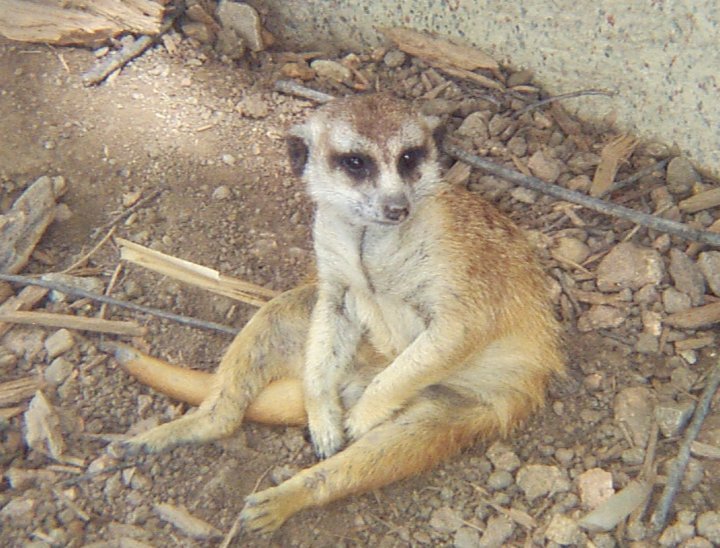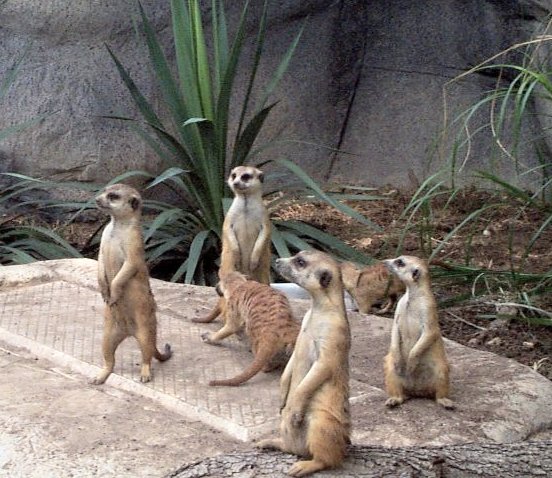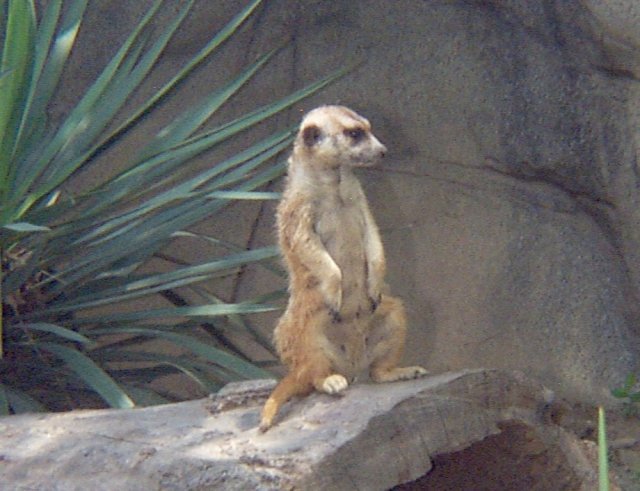 General information: Meerkats are
small mammals who are most closely related to the mongooses. They are colonial
animals, so they are very social within their own group. Behaviors that make
this evident are that they will share food, and groom, snuggle and lick each
other often, as well as before settling down to sleep in a large pile similar
to canine puppies. General information: Meerkats are
small mammals who are most closely related to the mongooses. They are colonial
animals, so they are very social within their own group. Behaviors that make
this evident are that they will share food, and groom, snuggle and lick each
other often, as well as before settling down to sleep in a large pile similar
to canine puppies. Meerkats form groups in order to survive. Being
such small animals, they are very susceptible to larger predators. However,
when they are part of a larger group, there is a division of labor, a sharing
of resources, and greater strength in numbers.
Meerkats perform specific roles, hence the division of labor. The members of
the group specialize in one of these specific roles, such as guard duty,
babysitting the young, foraging, and sharing food. Even though each member has
his or her own job, the meerkats are relieved of their duties by others so that
they can eat. Each takes a turn at babysitting and guard duty for short periods
of time. These duties are exhausting, and the willingness to share the labor
displays the cohesion of the group.
As seen by their sleeping arrangements, the meerkats are a closely knit
group. This closeness is evident in the daytime as well. During the day, the
meerkats forage for food out in the open savannah. This could be dangerous, but
each member of the group takes a turn at guard duty by pausing briefly to stand
erect and scan the skies for pedators. At other times, one of the meerkats who
has specialized in guard duty will perch as high as 12 feet on a branch to
watch the skies. His constant peeping lets the group know that the skies are
clear.
When one guard is relieved by the other, he is very hungry. This is due to
the fact that meerkats are used to eating every few minutes. At each step they
paw and sniff the ground until they smell food. They then begin a digging
frenzy, sending the sand flying, until they capture the prey. They can move
their own weight in sand in a matter of seconds, which is important when their
dinner is running away.
The sand also flies when the meerkats use their specialized claws to dig
burrows. These burrows are extensive passages that can cover many underground
miles. They are used for sleeping, escaping from predators and the hot sun, and
raising their kits to maturity.
 Although meerkats are very social within their own group, they are very
intent upon driving away intruders. They will either group together when
threatened to form what appears to be a giant, hissing animal, or they will
fiercely drive another group of meerkats out of their territory. This second
behavior is done by performing a type off "war dance" that consists
of each meerkat jumping higher and higher in the air and jeering loudly. They
progressively move forward, then suddenly stop and start vigorously pawing the
ground. This action causes what looks like smoke signals to rise into the air.
The war dance and smoke signals are the meerkat's way of intimidating outsiders
by making themselves appear stronger and more numerous. The victorous group
will then mark the losing group's territory with their waste.
Although meerkats are very social within their own group, they are very
intent upon driving away intruders. They will either group together when
threatened to form what appears to be a giant, hissing animal, or they will
fiercely drive another group of meerkats out of their territory. This second
behavior is done by performing a type off "war dance" that consists
of each meerkat jumping higher and higher in the air and jeering loudly. They
progressively move forward, then suddenly stop and start vigorously pawing the
ground. This action causes what looks like smoke signals to rise into the air.
The war dance and smoke signals are the meerkat's way of intimidating outsiders
by making themselves appear stronger and more numerous. The victorous group
will then mark the losing group's territory with their waste.
|

